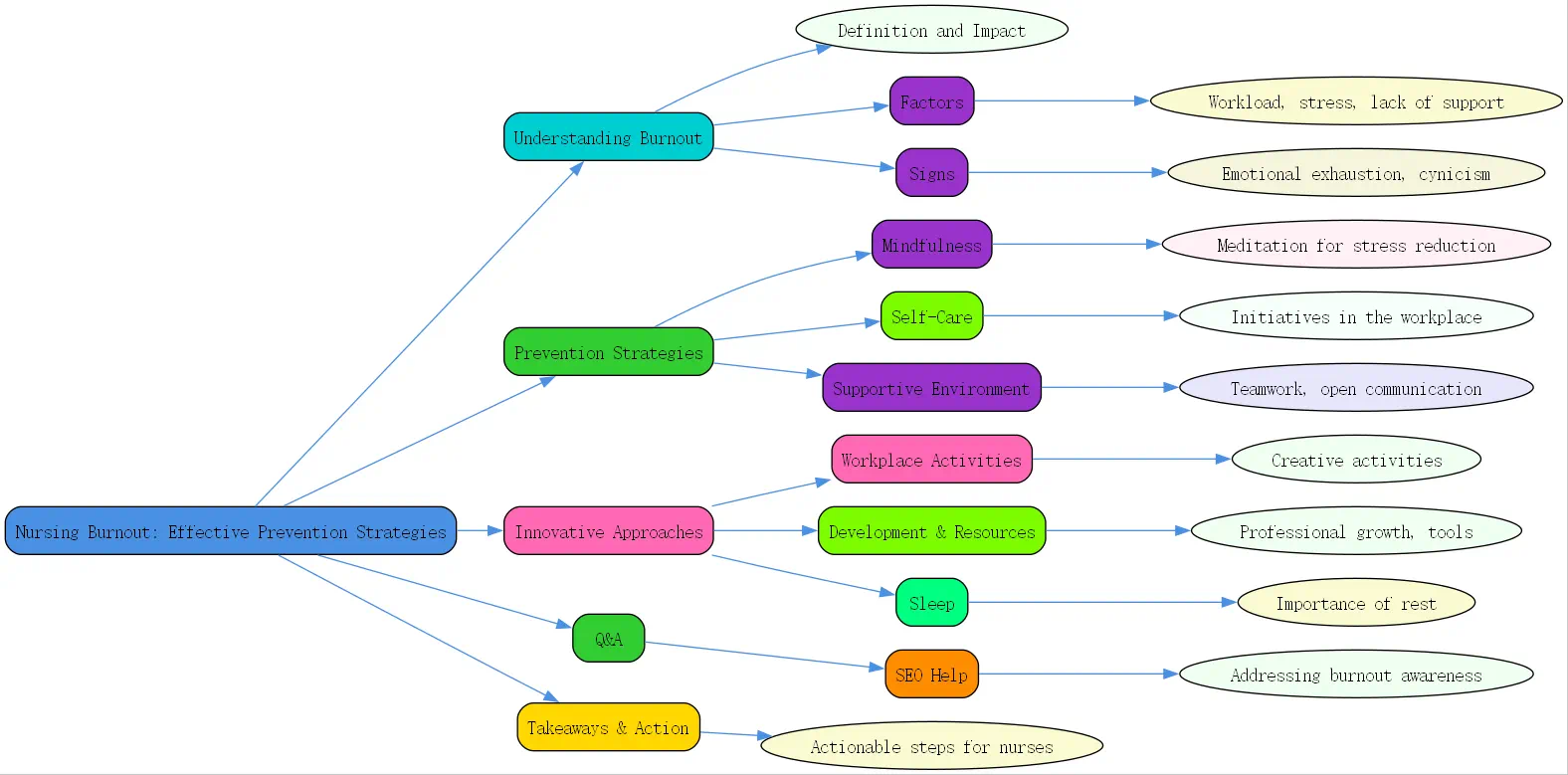Nursing burnout is a pressing concern that affects healthcare professionals worldwide. At BrainTalking, we’re committed to shedding light on this issue and offering practical solutions. This guide dives deep into understanding nursing burnout, explores proven prevention strategies, and highlights innovative approaches to keep nurses thriving. Whether you’re a nurse seeking relief or a leader aiming to support your team, you’ll find actionable insights here to combat burnout and nursing challenges.
Understanding Nursing Burnout

What is Nursing Burnout?

Nursing burnout is a state of chronic physical, emotional, and mental exhaustion triggered by prolonged stress in the nursing field. It’s marked by overwhelming fatigue, cynicism, and a diminished sense of achievement. This isn’t just a personal struggle—it ripples out, affecting patient care quality and staff retention. Addressing nursing burnout is vital to ensure nurses remain healthy and the healthcare system stays strong.
Beyond the textbook definition, burnout in nursing feels like a heavy weight that builds over time. Nurses pour their hearts into their work, often in high-stakes settings where every decision counts. When that effort isn’t balanced with rest or recognition, burnout creeps in. It’s a silent crisis that demands attention for the sake of both nurses and their patients.
Factors Contributing to Burnout in Nursing
Several elements fuel burnout in nursing. High-stress environments top the list—nurses frequently juggle life-and-death scenarios with little room for error. Long hours and erratic shift schedules throw off sleep and recovery, while the emotional toll of patient care weighs heavily. Add in the struggle to maintain work-life balance, and it’s clear why nursing and burnout often go hand in hand.
These factors don’t exist in isolation; they compound each other. Imagine a nurse pulling a 12-hour night shift, then facing a patient’s loss the next day. Sleep deprivation amplifies emotional strain, and with no time to recharge, resentment can build. Compassion fatigue—a real risk in this field—further deepens the burnout cycle, making prevention strategies essential.
Recognizing the Signs of Burnout Nursing

Spotting burnout early can make all the difference. Emotional exhaustion leaves nurses feeling drained, unable to face another shift. Cynicism or detachment might show up as a loss of empathy, a stark shift from their usual care. A drop in personal accomplishment makes efforts feel pointless, while physical signs like fatigue, insomnia, or headaches signal the body’s distress.
Nurses and managers alike need to stay alert. If a once-passionate nurse grows indifferent or dreads the job, it’s a red flag. Physical symptoms often get brushed off as “part of the gig,” but they’re clues to burnout nursing. Catching these signs early opens the door to support and recovery before the damage deepens.
Effective Strategies for Nursing and Burnout Prevention
Mindfulness and Meditation Techniques for Nurses
Mindfulness is a game-changer for tackling nursing burnout. By staying present, nurses can dial down stress and regain control. Quick practices like deep breathing or guided imagery fit into even the busiest shifts. The Free Mindfulness Project offers free resources—perfect for nurses needing accessible, burnout-busting tools.
Picture this: a nurse starts their day with a five-minute breathing exercise. It’s simple, but it resets their mindset, cutting through the chaos. During a hectic shift, a moment of mindfulness before a tough task can sharpen focus and ease anxiety. These small habits build resilience, making burnout and nursing less of a constant battle.
Self-Care Initiatives in the Workplace
Self-care isn’t just a buzzword—it’s a lifeline. Mental Health Days let nurses step back when their minds need a break, just like they would for a cold. A quiet room for relaxation or meditation offers an escape from the storm of a hospital floor. Yoga or creative outlets like art therapy can recharge nurses, too.
Hospitals that prioritize these initiatives show nurses they’re valued. A “nap room” for quick rests during long shifts isn’t a luxury—it’s a necessity that boosts performance and fights fatigue. When workplaces champion self-care, they’re not just preventing burnout in nursing; they’re fostering a culture of well-being that keeps staff strong.
Building a Supportive Work Environment
A solid support system can shield nurses from burnout. Open communication and teamwork break down isolation, while peer support programs let nurses share struggles and solutions. Pushing for fair workloads and schedules ensures no one’s stretched too thin, preserving that crucial work-life balance.
Leadership sets the tone here. Managers trained to spot burnout can step in early with resources or a listening ear. Regular check-ins catch brewing issues before they boil over. A workplace that lifts its nurses up—rather than piling on—creates a team ready to handle anything, reducing nursing and burnout risks.
Innovative Approaches to Combat Burnout in Nursing
Creative Workplace Activities
Fun can be a powerful antidote to stress. Themed “PJ days” bring a laid-back vibe, easing tension whether nurses are at home or in the office. Pizza days or a hot chocolate bar with toppings spark joy and connection. International food days celebrate diversity, blending inclusion with a tasty break from routine.
These ideas sound lighthearted, but they work. A relaxed day in pajamas can shift the mood, making the job feel less daunting. Sharing food—especially from different cultures—builds bonds and reminds nurses they’re part of a team. It’s a simple, budget-friendly way to tackle burnout nursing head-on.

Professional Development and Resources
Growth opportunities can reignite a nurse’s spark. Workshops on time management—think Marie Kondo’s “spark joy” approach—help tame chaotic schedules. Mindfulness retreats, like one planned for 2025, offer deep renewal. Securing grants, as some districts have with the Colorado Education Initiative, can fund these wellness boosts.
Investing in nurses pays off. A session on organizing workloads might cut stress by making days feel manageable. Retreats give a rare chance to step back and recharge fully. When healthcare systems back these programs, they signal that burnout in nursing isn’t inevitable—it’s preventable with the right tools.
The Importance of Sleep and Rest
Sleep is non-negotiable for beating burnout. Nap rooms or rest zones at work honor the physical grind of nursing, offering a spot to recover. Education on sleep deprivation’s toll—linked to burnout and health issues—drives the point home. Tips like sticking to a sleep routine can transform rest quality.
Nurses often push through exhaustion, but that’s a losing battle. A 20-minute nap in a comfy space can sharpen focus and lift spirits. Teaching the science of sleep empowers nurses to prioritize it, countering the irregular shifts that fuel nursing burnout. Rest isn’t a luxury—it’s a cornerstone of resilience.
Q&A Section
How Can SEO Help in Addressing Nursing Burnout?
SEO makes burnout solutions accessible. By weaving keywords like “nursing burnout” into content, BrainTalking ensures nurses and leaders find this guide easily. High search rankings connect people with tips on mindfulness or self-care fast—crucial when burnout strikes.
Take a nurse Googling “burnout in nursing help.” An SEO-savvy article pops up, offering instant strategies. Internal links, like to nursing interventions to manage anxiety, guide them further. SEO builds trust, too—well-researched content signals reliability, vital in healthcare. It’s a bridge between need and knowledge.
Takeaways and Actionable Steps
- Try Mindfulness: Kick off each day with a quick meditation to lower stress.
- Claim Mental Health Days: Take a break when your mind needs it—no guilt.
- Join Fun Activities: Suggest or enjoy PJ days and food events at work.
- Guard Your Sleep: Push for rest areas and stick to a sleep schedule.
- Lean on Support: Tap into peer programs and talk openly with your team.




